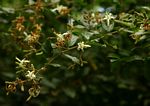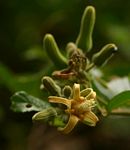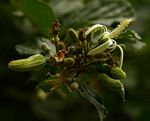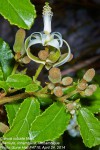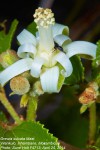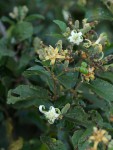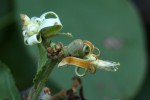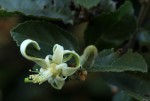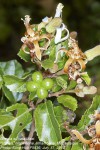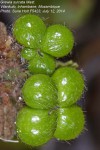| Home | > | List of families | > | Malvaceae subfamily Grewioideae | > | Grewia | > | sulcata |
Grewia sulcata
Selected images: Click on each image to see a larger version and details of the record View all images (14)
Detailed records: Display species records QDS maps by: Google Maps Point records by Google Maps
Species details: Click on each item to see an explanation of that item (Note: opens a new window)
| Synonyms: |
Grewia obovata K. Schum. |
| Common names: | Stellar raisin (English) |
| Frequency: | Locally common |
| Status: | Native |
| Description: |
A multi-stemmed, scrambling shrub or small tree. Bark reddish-brown with conspicuous lenticels. Leaves obovate to oblong, 2-7 cm long, 3-veined from the base, with scattered rough stellate hairs on both surfaces; base asymmetric; margin scalloped or toothed. Flowers white or cream, c. 3.5 cm in diameter, in few-flowered, axillary heads; sepals reflexed, green with woolly hairs on the outside, petals much shorter; stamens hardly spreading, forming a central column. Fruit 1.5-2 cm in diameter, usually deeply 4-lobed, sometimes 2-lobed, somewhat fleshy. |
| Type location: |
|
| Notes: | |
| Derivation of specific name: | sulcata: grooved |
| Habitat: | In riverine fringes and coastal dune vegetation, often on sandy soils. |
| Altitude range: (metres) | Up to 700 m |
| Flowering time: | |
| Worldwide distribution: | Tanzania, Malawi, Mozambique , Zimbabwe, and Mpumalanga, South Africa |
| National distribution: | N,Z,T,MS,GI,M |
| Growth form(s): | |
| Endemic status: | |
| Red data list status: | |
| Insects associated with this species: | |
| Spot characters: | Display spot characters for this species |
| Images last updated: | Monday 22 December 2014 |
| Literature: |
Burrows, J.E., Burrows, S.M., Lötter, M.C. & Schmidt, E. (2018). Trees and Shrubs Mozambique Publishing Print Matters (Pty), Cape Town. Page 580. (Includes a picture). Drummond, R.B. (1975). A list of trees, shrubs and woody climbers indigenous or naturalised in Rhodesia. Kirkia 10(1) Page 259. Mapaura, A. & Timberlake, J. (eds) (2004). A checklist of Zimbabwean vascular plants Southern African Botanical Diversity Network Report No. 33 Sabonet, Pretoria and Harare Page 81. Wild, H. (1963). Tiliaceae Flora Zambesiaca 2(1) Pages 56 - 57. |
Other sources of information about Grewia sulcata:
Our websites:
Flora of Malawi: Grewia sulcataFlora of Zimbabwe: Grewia sulcata
External websites:
African Plants: A Photo Guide (Senckenberg): Grewia sulcataAfrican Plant Database: Grewia sulcata
BHL (Biodiversity Heritage Library): Grewia sulcata
EOL (Encyclopedia of Life): Grewia sulcata
GBIF (Global Biodiversity Information Facility): Grewia sulcata
Google: Web - Images - Scholar
iNaturalist: Grewia sulcata
IPNI (International Plant Names Index): Grewia sulcata
JSTOR Plant Science: Grewia sulcata
Mansfeld World Database of Agricultural and Horticultural Crops: Grewia sulcata
Plants of the World Online: Grewia sulcata
Tropicos: Grewia sulcata
Wikipedia: Grewia sulcata
| Home | > | List of families | > | Malvaceae subfamily Grewioideae | > | Grewia | > | sulcata |
